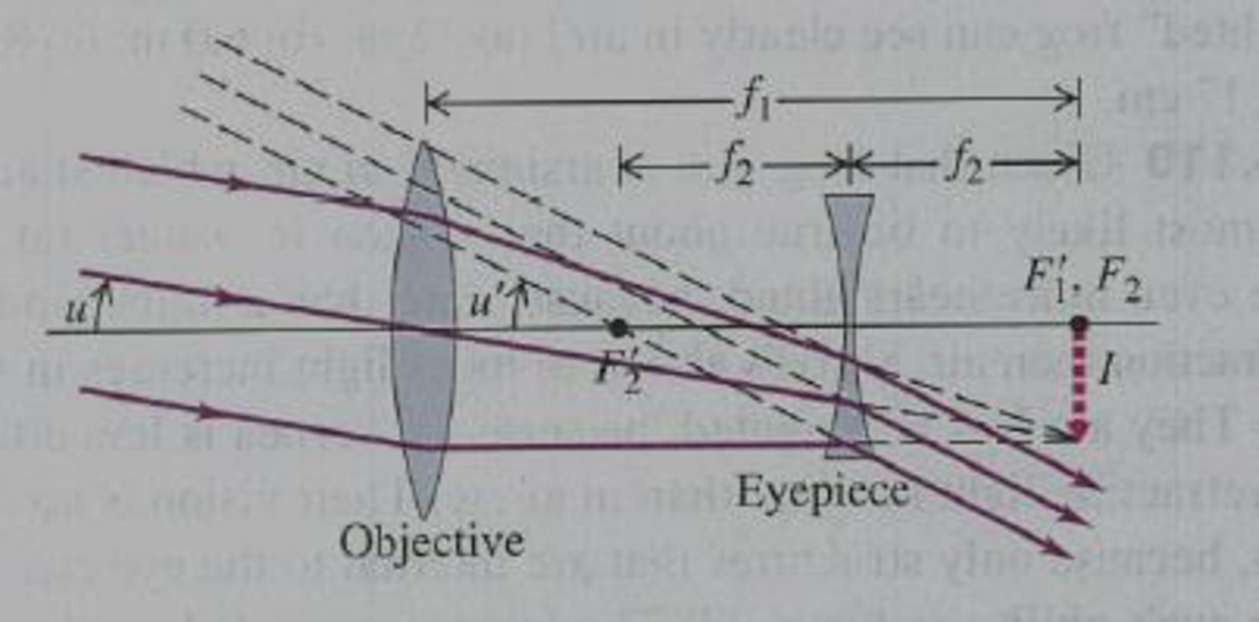
Concept explainers
The Galilean Telescope. Figure P34.100 is a diagram of a Galilean telescope, or opera glass, with both the object and its final image at infinity. The image I serves as a virtual object for the eyepiece. The final image is virtual and erect. (a) Prove that the angular magnification is M = −f1/f2. (b) A Galilean telescope is to be constructed with the same objective lens as in Exercise 34.61. What focal length should the eyepiece have if this telescope is to have the same magnitude of angular magnification as the one in Exercise 34.61? (c) Compare the lengths of the telescopes.
Figure P34.100

Want to see the full answer?
Check out a sample textbook solution
Chapter 34 Solutions
University Physics (14th Edition)
Additional Science Textbook Solutions
Physics: Principles with Applications
College Physics: A Strategic Approach (4th Edition)
Physics (5th Edition)
Cosmic Perspective Fundamentals
An Introduction to Thermal Physics
- Two converging lenses having focal lengths of f1 = 10.0 cm and f2 = 20.0 cm are placed a distance d = 50.0 cm apart as shown in Figure P35.48. The image due to light passing through both lenses is to be located between the lenses at the position x = 31.0 cm indicated. (a) At what value of p should the object be positioned to the left of the first lens? (b) What is the magnification of the final image? (c) Is the final image upright or inverted? (d) Is the final image real or virtual?arrow_forwardFigure P38.43 shows a concave meniscus lens. If |r1| = 8.50 cm and |r2| = 6.50 cm, find the focal length and determine whether the lens is converging or diverging. The lens is made of glass with index of refraction n = 1.55. CHECK and THINK: How do your answers change if the object is placed on the right side of the lens? FIGURE P38.43arrow_forwardA converging lens made of crown glass has a focal length of 15.0 cm when used in air. If the lens is immersed in water, what is its focal length? (a) negative (b) less than 15.0 cm (c) equal to 15.0 cm (d) greater than 15.0 cm (e) none of those answersarrow_forward
- In Figure P26.38, a thin converging lens of focal length 14.0 cm forms an image of the square abcd, which is hc = hb = 10.0 cm high and lies between distances of pd = 20.0 cm and pa = 30.0 cm from the lens. Let a, b, c, and d represent the respective corners of the image. Let qa represent the image distance for points a and b, qd represent the image distance for points c and d, hb represent the distance from point b to the axis, and hc represent the height of c. (a) Find qa, qd, hb, and hc. (b) Make a sketch of the image. (c) The area of the object is 100 cm2. By carrying out the following steps, you will evaluate the area of the image. Let q represent the image distance of any point between a and d, for which the object distance is p. Let h represent the distance from the axis to the point at the edge of the image between b and c at image distance q. Demonstrate that h=10.0q(114.01q) where h and q are in centimeters. (d) Explain why the geometric area of the image is given by qaqdhdq (e) Carry out the integration to find the area of the image. Figure P26.38arrow_forwardTwo thin lenses of focal lengths f1 = 15.0 and f2 = 10.0 cm, respectively, are separated by 35.0 cm along a common axis. The f1 lens is located to the left of the f2 lens. An object is now placed 50.0 cm to the left of the f1 lens, and a final image due to light passing though both lenses forms. By what factor is the final image different in size from the object? (a) 0.600 (b) 1.20 (c) 2.40 (d) 3.60 (e) none of those answersarrow_forwardWhy is the following situation impossible? Consider the lensmirror combination shown in Figure P35.55. The lens has a focal length of fL = 0.200 m, and the mirror has a focal length of fM = 0.500 m. The lens and mirror are placed a distance d = 1.30 m apart, and an object is placed at p = 0.300 m from the lens. By moving a screen to various positions to the left of the lens, a student finds two different positions of the screen that produce a sharp image of the object. One of these positions corresponds to light leaving the object and traveling to the left through the lens. The other position corresponds to light traveling to the right from the object, reflecting from the mirror and then passing through the lens. Figure P35.55 Problem 55 and 57.arrow_forward
- A man inside a spherical diving bell watches a fish through a window in the bell, as in Figure P23.26. If the diving bell has radius R = 1.75 m and the fish is a distance p = 1 00 m from the window, calculate (a) the image distance and (b) the magnification. Neglect the thickness of the window. Figure P23.26arrow_forwardA man inside a spherical diving bell watches a fish through a window in the bell, as in Figure P23.26. If the diving bell has radius R = 1.75 m and the fish is a distance p = 1 00 m from the window, calculate (a) the image distance and (b) the magnification. Neglect the thickness of the window. Figure P23.26arrow_forwardA certain LCD projector contains a single thin lens. An object 18.0 mm high is to be projected so that its image fills a screen 3.30 m high. The object-to-screen distance is 4.90 m. (a) Find the magnification of the image. A certain LCD projector contains a single thin lens. An object 18.0 mm high is to be projected so that its image fills a screen 3.30 m high. The object-to-screen distance is 4.90 m. (b) How far from the object should the lens of the projector be placed to form the image on the screen? A certain LCD projector contains a single thin lens. An object 18.0 mm high is to be projected so that its image fills a screen 3.30 m high. The object-to-screen distance is 4.90 m. (c) Determine the focal length of the projection lens.arrow_forward
- The projection lens in a certain slide projector is a single thin lens. A slide 23.8 mm high is to be projected so that its image fills a screen 1.89 m high. The slide-to-screen distance is 3.06 m. (a) Determine the focal length of the projection lens. 35.2 What is the relationship between the slide-to-screen distance and the object and image distances? mm (b) How far from the slide should the lens of the projector be placed to form the image on the screen? mmarrow_forwardparasaurolophus 4. A tiny is standing 12 cm in front of a spherical lens with a refractive power of 12.5 D, and the lens is sitting 14 cm in front of a spherical mirror with a focal length of 40 cm as shown in the figure. (a) (b) (c) (1) -14 cm. What is the final image distance? What is its magnification? 2 cm The final image is real ☐ virtual Sketch the final image in the figure at the correct location, with the proper orientation and correct size (relative to the object). You can draw an arrow instead of a parasaurolophus. :)arrow_forwardI use a converging lens of 300 mm focal length to project the image of a A4 transparency (height of 29.7 cm) onto a wall which is at a distance of 2.10 m from the lens. For a focussed image the distance from the transparency to the lens must be mm (write 3 significant figures without a possible negative sign). The algebraic magnification of the projection is (write 1 significant figures). The height of the image is cm (write 3 significant figures without a possible negative sign).arrow_forward
 Principles of Physics: A Calculus-Based TextPhysicsISBN:9781133104261Author:Raymond A. Serway, John W. JewettPublisher:Cengage Learning
Principles of Physics: A Calculus-Based TextPhysicsISBN:9781133104261Author:Raymond A. Serway, John W. JewettPublisher:Cengage Learning College PhysicsPhysicsISBN:9781305952300Author:Raymond A. Serway, Chris VuillePublisher:Cengage Learning
College PhysicsPhysicsISBN:9781305952300Author:Raymond A. Serway, Chris VuillePublisher:Cengage Learning College PhysicsPhysicsISBN:9781285737027Author:Raymond A. Serway, Chris VuillePublisher:Cengage Learning
College PhysicsPhysicsISBN:9781285737027Author:Raymond A. Serway, Chris VuillePublisher:Cengage Learning Physics for Scientists and EngineersPhysicsISBN:9781337553278Author:Raymond A. Serway, John W. JewettPublisher:Cengage Learning
Physics for Scientists and EngineersPhysicsISBN:9781337553278Author:Raymond A. Serway, John W. JewettPublisher:Cengage Learning Physics for Scientists and Engineers with Modern ...PhysicsISBN:9781337553292Author:Raymond A. Serway, John W. JewettPublisher:Cengage Learning
Physics for Scientists and Engineers with Modern ...PhysicsISBN:9781337553292Author:Raymond A. Serway, John W. JewettPublisher:Cengage Learning Physics for Scientists and Engineers: Foundations...PhysicsISBN:9781133939146Author:Katz, Debora M.Publisher:Cengage Learning
Physics for Scientists and Engineers: Foundations...PhysicsISBN:9781133939146Author:Katz, Debora M.Publisher:Cengage Learning





